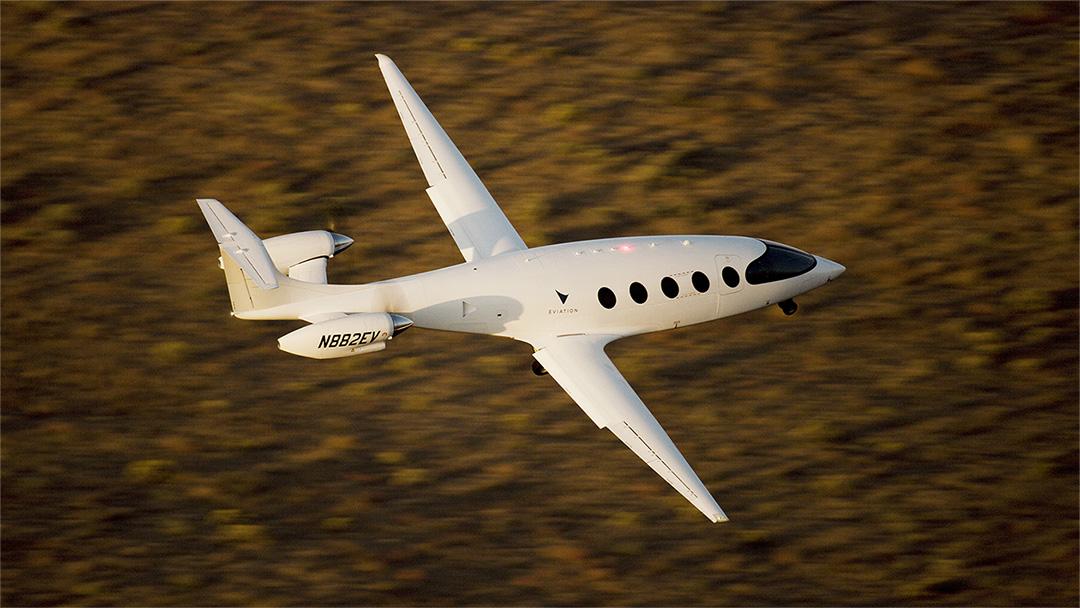
Aircraft developer Eviation is using masses of data from the first flight of its all-electric Alice commuter aircraft last year to inform the design of the production version, but says it has no plans to fly the prototype again soon.
Although only eight minutes in duration, the Sept. 27 flight generated terabytes of data says Greg Davis, Eviation’s CEO and president, who notes, “We had every element of the aircraft instrumented.” Flown from Moses Lake’s Grant County International Airport, Washington, by Eviation test pilot Steve Crane, the 57-ft.-long twin-engine aircraft reached an altitude of 3,500 ft. and speed of 149 kt. during its short debut flight.
Post-flight analysis verified that overall aircraft and energy system performance compared well with predictions, boosting Eviation’s confidence in the design tools and models used to develop Alice. “We had good correlation. We had some key findings about things like how much energy the aircraft consumed. It did what we thought it was going to do,” says Davis.
Eviation’s analysis has focused on the performance of Alice’s twin 850 shp/640-kW magni650 electric propulsion units (EPUs) at various power settings, as well as the aircraft’s basic handling qualities and maneuvering characteristics. “The findings were excellent,” says Davis, who adds: “We will fly the airplane again when the time calls for it. We don’t have an immediate need to go and find out anything more about the airplane.”
Eviation is now “focusing our activity on things like supplier selection and advancing the design for the certification version of the aircraft, which is going to be a derivative of the prototype that we flew,” says Davis. The prototype, which is being retained as a technology development test aircraft, has therefore fulfilled its initial purpose, he adds.
“It demonstrated all the technology that you need to make a commercially producible electric commuter aircraft: the batteries, the EPUs, the pilot displays, the flight control system, the high voltage system and other parts. We proved all of that technology on our first flight—it all worked together, and the information that we got was sufficient for us to move on to the next phase of development,” Davis says.
Certification Article
For the design of the “certification article”—as Eviation calls the production version—the company is targeting a simpler-to-build configuration with fewer parts and more advanced, mid-late 2020s state-of-the-art batteries. Although externally similar to the prototype, the conforming aircraft will incorporate several differences including single-piece rudder and ailerons in place of the split control surfaces on the prototype. The trailing edge flaps will also be increased in area on the production model to improve field performance.
The nine-passenger aircraft is designed to fly 250 nm on an 8,300-lb. battery pack housed beneath the fuselage in two large compartments, each incorporating 56 segmented containers called cassettes. In the prototype, each cassette contains 192 cells for a total of over 21,000 individual cells, all of which are constantly monitored for correct voltage, temperature, charging and discharging status. Individual cassettes can be shut down in the event of a failure.
“We know that battery technology is going to change and so we’ve designed our architectures so that we will be able to change the cell level battery technology as it advances,” says Davis. “That’ll let you do more with the aircraft, so you can fly a bit further or faster, or ultimately just decrease the size of the batteries and have more useful load on the aircraft. There’s a lot that’s going to happen there.” The energy density of batteries is currently increasing at around 3% per year, meaning that by 2027 the aircraft should have around 20% more available energy than at present, he notes.
Eviation expects to finalize the design of the production Alice version by 2025. Three conforming aircraft will be made for the test program, with the second and third aircraft likely to become serial numbers one and two.
“Then at some point in time, during the test program, we will kick off the production run of the aircraft as well so that we can be ready to deliver aircraft in 2027,” Davis says. The Alice will be certified under Part 23 amendment level 64, plus special conditions.




